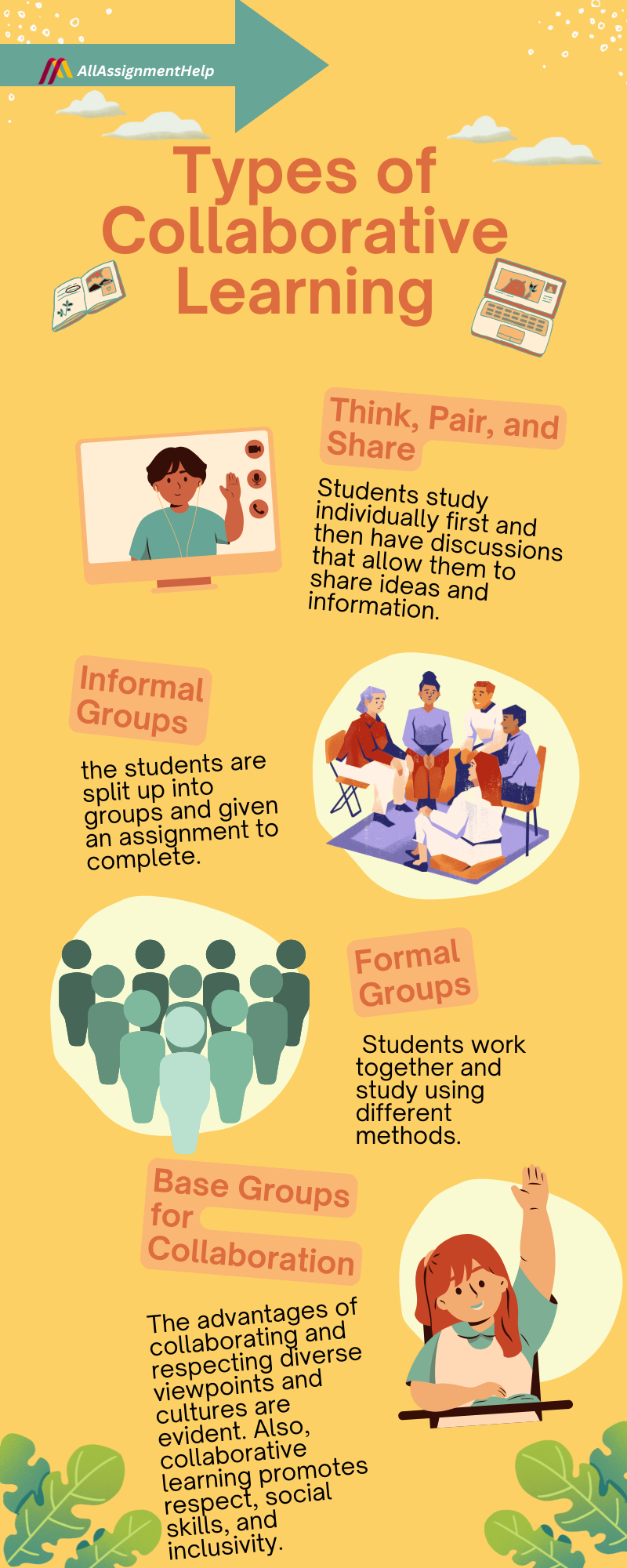Table of Contents
Students collaborate in smaller groups to accomplish a shared objective in a collaborative learning environment. Similar to the traditional learning model, collaborative learning teachers still guide students and help direct the learning process
Students can actively participate in their education through collaborative learning by exchanging ideas, evaluating issues, and developing solutions. They collectively accomplish learning objectives and build expertise.
Collaborative learning can take place in bigger groups or among peers. Peer learning, often known as peer instruction, is a form of cooperative learning in which students exchange ideas or work through issues in small groups or pairs. According to educational scholars, peer instruction allows students to teach one another by correcting and clarifying misconceptions, which is similar to the concept that two or three heads are better than one.
So, if you are planning to be a part of collaborative learning, then go for it. And read this blog by allassignmenthelp, to know collaborative learning strategies, their advantages, and practical tips for educators to promote student-centred learning.
Read Also: Do My Economics Homework
What is Collaborative Learning?
Groups of students and teachers work together on cooperative intellectual projects as part of collaborative learning. Students usually work together in groups of two or more to find solutions, learn new things, or create something. Collaborative learning includes problem-centred, student-centred, and experiential learning. Teachers must “create a context where learners can discover on their own and successfully reconstruct their understanding of the world around them.
The idea behind collaborative learning is that students need to actively engage with new knowledge or skills to connect them with what they already know.
Services like online assignment help are useful in this process. They allow students to get expert support when working on group projects or tough topics. These platforms help explain difficult concepts, offer examples, and give quick feedback. This way, students can focus more on teamwork and learning, while also improving their understanding with the help of professional guidance.
Read More: Smart Classrooms vs. Traditional Classrooms: A Comparative Guide
Fundamentals of Collaborative Learning
Some of the fundamental tenets of collaborative learning are individual responsibility, positive interdependence, social skills, promotive interaction, and group processing.
- Individual accountability means each student is responsible for their part of the group work. It makes sure everyone helps and is part of the final result. This also stops some students from doing nothing and still getting credit for the team’s work.
- Students who work together positively help and support each other while completing their tasks. This kind of teamwork, called promotive interaction, involves explaining ideas, asking questions, giving helpful feedback, encouraging one another, and most importantly, staying actively involved in learning.
- A cohesive group needs social abilities like leadership, communication, and dispute resolution to work well. These pupils must possess these abilities to succeed.
- Students who show positive interdependence can both succeed and fail as a team because each member’s participation makes the team successful. By fostering a sense of collective synergy, positive interdependence enables students to collaborate and accomplish their common objectives. Lastly, group processing is the process by which the group evaluates how well it performs in achieving its objectives and maintaining productive working relationships.
- Also, the group may find and analyse areas for improvement through group processing. When used effectively, collaborative learning can be highly advantageous for students.
So these are core areas of collaborative learning. Students definitely learn something useful and develop cooperative behaviour. However, not all students find it easy to manage group work, online classes, and other academic responsibilities at the same time. In such cases, some students look for trusted academic support and ask experts, Can you take my online class? These services can provide guidance with assignments, manage deadlines, and keep students actively involved in their learning journey, without falling behind in collaborative or individual tasks.
Types of Collaborative Learning
Below are the different types of collaborative learning:

Think, Pair, and Share
This is the most popular kind of collaborative learning, where students study individually first and then have discussions that allow them to share ideas and information.
Informal Groups for Collaborative Learning
In this kind of learning, the students are split up into groups and given an assignment to complete. As a result, students spend less time listening to lectures in class and retain more information.
Formal Groups for Collaborative Learning
Members of the group must remain together for weeks or months to complete assignments as part of this collaborative learning approach. Here, students work together and study using different methods.
Learning Based on Problems
This method offers a problem for students to evaluate and solve in groups. In this case, students must comprehend an issue before coming up with a solution.
Base Groups for Collaboration
Groups established for a minimum of one year make up collaborative base organisations. Teams with diverse viewpoints and mindsets are included so that they can offer their suggestions for a project.
No matter what type of learning you are involved in, you can get help online if you face problems while learning. If you think you don’t get enough time to complete your academic work, such as math assignments, science homework or any other projects. Whether it is programming assignment help, English homework help, math assignment help, or help with any other task, expert help is just a click away.
These services save you time, reduce stress, and ensure your assignments are completed on time. Getting the right guidance can also help you better understand tough topics and improve your academic performance.
Benefits of Collaborative Learning
The advantages of collaborating and respecting diverse viewpoints and cultures are evident. Also, collaborative learning promotes respect, social skills, and inclusivity.
Because students help each other learn, collaborative learning can lighten the professor’s workload. Instead of lecturing and directing learning, the professor might now take on the role of a facilitator, offering guidance and observation. Here are some other benefits of collaborative learning:
Enhances the ability to solve problems
Groups often have to finish tasks or find solutions to problems as part of collaborative learning projects. To determine the optimal option, the group must debate and evaluate several concepts. Collaborating on an assignment or problem can help professionals find fresh approaches to dealing with various scenarios at work or help students improve their problem-solving abilities.
Promotes social contact
Students must engage as a team through vocal communication, eye contact, and social cues in order to participate in collaborative learning. Working toward a similar objective teaches people of different personality types to listen and share. Students practice and grow in social skills, including respect, empathy, and active listening, during this process. Strong interpersonal and professional relationships can be formed and maintained with the use of social skills.
Supports diversity
People of different ages, ethnicities, views, and educational levels frequently come together through collaborative learning. Participants in the solution-finding process are exposed to a range of potential explanations from individuals with diverse viewpoints and ideas. Members of the team may provide novel points of view that are specific to their culture or upbringing. Collaborative learning can promote tolerance and acceptance in the workplace.
Improves the ability to communicate
Successful communication is essential to collaborative learning. Verbal communication skills are used by participants to exchange ideas, clarify concepts, and give succinct, understandable criticism. If the job includes peer editing or group writing, learners may also have the chance to enhance their written communication abilities.
Allows innovation
Collaborative learning assignments can yield innovative solutions by combining diverse perspectives and ideas. One person’s concept or idea may stimulate their team colleagues to come up with a fresh, original idea. Because a variety of perspectives and ideas frequently assist team members in finding a workable solution to an issue, collaborative learning fosters this kind of creative thinking.
Develops critical thinking abilities
Higher-level thinking can be developed by collaborative learning. Collaborative projects involve students analysing and discussing data in order to solve problems or finish tasks. Collaborative assignments help professionals and students develop their critical-thinking abilities since these groups encourage team members to interpret and evaluate the views of others as well as explain their own. Resolving disputes, coming up with ideas for new tactics, producing material, and assessing concepts and outcomes all require critical thinking.
Thus, relationships can be strengthened and new connections formed through collaborative learning. It often brings people together who otherwise would not have crossed paths or collaborated. Team members get to know one another better as they work together on a collaborative learning project. Members of the team learn more about one another as they work together on a collaborative learning project. Positive personal and professional relationships, as well as increased morale, may result from this.
Read More: Online Physics Degrees: Are They Useful in Today’s Scenario?
Conclusion
Collaborative learning is a powerful teaching approach that promotes deeper understanding, strengthens critical thinking skills, and boosts student motivation and engagement. Students collaborate in small groups to actively create knowledge and learn from one another. But as was already mentioned, putting collaborative learning into practice successfully may call for the professor to carefully design, scaffold, and facilitate. On the other hand, it’s critical to address possible issues with classroom management, unequal participation, and alignment with learning objectives.
FAQs
1. What is collaborative learning?
When students collaborate in groups to solve issues, exchange ideas, and gain knowledge from one another, this is known as collaborative learning.
2. What is the significance of collaborative learning?
Learning with others helps kids think critically, communicate more effectively, and have a deeper understanding of subjects.
3. How is group work different from collaborative learning?
In group work, duties may be simply distributed among members, but in collaborative learning, everyone actively participates and aids each other’s learning.
4. What abilities do students acquire through group projects?
Students gain knowledge of problem-solving techniques, leadership, teamwork, and how to provide and accept feedback.
5. Is it possible to do online collaborative learning?
Yes, students can collaborate and learn online by using shared documents, chat tools, and video chats.
